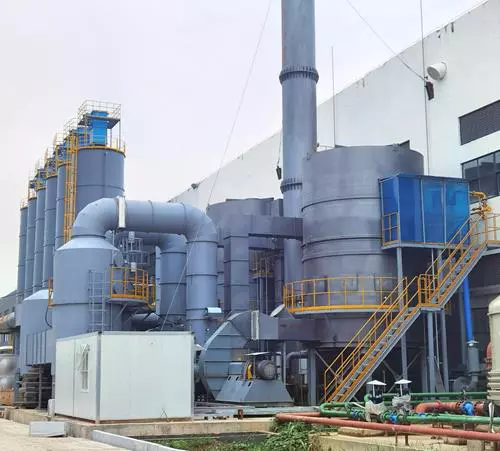Recuperative Thermal Oxidizer for Semiconductor Industry
介紹
Semiconductor manufacturing involves the use of various chemicals and solvents that emit harmful gases into the atmosphere. These gases contribute to air pollution, which is a significant environmental concern. To mitigate this problem, recuperative thermal oxidizers are increasingly being used in the semiconductor industry. Recuperative thermal oxidizers are pollution control devices that destroy harmful gases and odors emitted during the manufacturing process by converting them into harmless substances.
How does a Recuperative Thermal Oxidizer work?
A recuperative thermal oxidizer works by using high temperatures to convert harmful gases into harmless substances. The process involves heating the polluted air to a temperature of approximately 1500¡ãF while mixing it with an adequate amount of oxygen. The mixture is then passed through a heat exchanger that recovers the heat generated during the process. The heat is then used to preheat the incoming polluted air, reducing the amount of energy required to reach the desired temperature. As the gases flow through the combustion chamber, they are oxidized and converted into carbon dioxide, water vapor, and heat. The purified air is released into the atmosphere, while the heat generated can be recovered and used to preheat incoming air, reducing energy consumption.
Benefits of using Recuperative Thermal Oxidizers in Semiconductor Industry
Using recuperative thermal oxidizers in semiconductor manufacturing brings several benefits, including:
- Reduced air pollution: Recuperative thermal oxidizers reduce the amount of harmful gases emitted into the environment, thus reducing air pollution.
- Compliance with regulations: The use of recuperative thermal oxidizers helps to comply with environmental regulations and avoids penalties that may arise from non-compliance.
- Energy efficiency: Recuperative thermal oxidizers are energy-efficient, and the heat generated during the process can be recovered and used to preheat incoming air, reducing energy consumption.
- Cost savings: Recovering the heat generated during the process can lead to significant cost savings on energy bills, making recuperative thermal oxidizers a cost-effective solution.
- Improved workplace safety: The use of recuperative thermal oxidizers improves workplace safety by eliminating harmful gases, which can be dangerous when inhaled by workers.
Types of Recuperative Thermal Oxidizers
There are two main types of recuperative thermal oxidizers: the direct-fired recuperative thermal oxidizer and the indirect-fired recuperative thermal oxidizer.
Direct-fired Recuperative Thermal Oxidizer
Direct-fired recuperative thermal oxidizers are used when the concentration of volatile organic compounds (VOCs) is relatively high. The process involves burning the gases directly in the combustion chamber, and the heat generated is used to preheat the incoming air.
Indirect-fired Recuperative Thermal Oxidizer
Indirect-fired recuperative thermal oxidizers are used when the concentration of VOCs is low. The process involves heating the gases indirectly by passing them through a heat exchanger. The heat generated is then used to preheat the incoming air.
結論
Recuperative thermal oxidizers are an effective solution for reducing harmful gas emissions in the semiconductor industry. The benefits of using these devices include reduced air pollution, compliance with regulations, energy efficiency, cost savings, and improved workplace safety. The two main types of recuperative thermal oxidizers are direct-fired and indirect-fired, each with their specific applications. Adopting the use of recuperative thermal oxidizers in semiconductor manufacturing not only helps to protect the environment but also ensures compliance with government regulations and promotes workplace safety.

公司簡介
We are a high-tech manufacturing enterprise specializing in comprehensive treatment of volatile organic compound (VOC) exhaust gas and carbon reduction and energy-saving technologies. Our core technologies include thermal energy, combustion, sealing, and automatic control. We have capabilities in temperature field simulation, air flow field simulation modeling, ceramic heat storage material performance, molecular sieve adsorption material selection, and VOC high-temperature incineration and oxidation experimental testing.
團隊優勢
We have established an RTO technology research and development center and an exhaust gas carbon reduction engineering technology center in Xi’an, as well as a 30,000 square meter production base in Yangling. We are a leading manufacturer of RTO equipment and molecular sieve wheel equipment in terms of production and sales volume globally. Our core technical team comes from the Aerospace Liquid Rocket Engine Research Institute. We currently have over 360 employees, including more than 60 R&D technology backbones, including 3 senior engineers with research-level qualifications, 6 senior engineers, and 55 thermodynamics PhDs.
核心產品
Our core products include the Rotary Valve Thermal Oxidizer (RTO) and molecular sieve adsorption concentration wheel. Combined with our expertise in environmental protection and thermal energy system engineering, we can provide customers with comprehensive solutions for industrial exhaust gas treatment, carbon reduction, and thermal energy utilization under various operating conditions.
認證、專利和榮譽
- 智慧財產權管理系統認證
- 品質管理系統認證
- 環境管理系統認證
- 建築業企業資質
- 高新技術企業
- Patent for Rotary Valve Thermal Oxidizer
- Patent for Rotary Heat Storage Incineration Equipment
- Patent for Disc Molecular Sieve Wheel

選擇合適的 RTO 設備
- 確定廢氣特性
- 了解當地法規和排放標準
- 評估能源效率
- 考慮維
- 預算和成本分析
- 選擇合適的RTO類型
- 考慮環境和安全因素
- 效能測試與驗證
Explanation:

服務流程
- Consultation and evaluation
- Design and solution development
- Production and manufacturing
- Installation and commissioning
- After-sales support
Explanation:
我們是一站式解決方案提供商,擁有專業團隊致力於為客戶客製化RTO解決方案。
About the Author
作者:米婭
